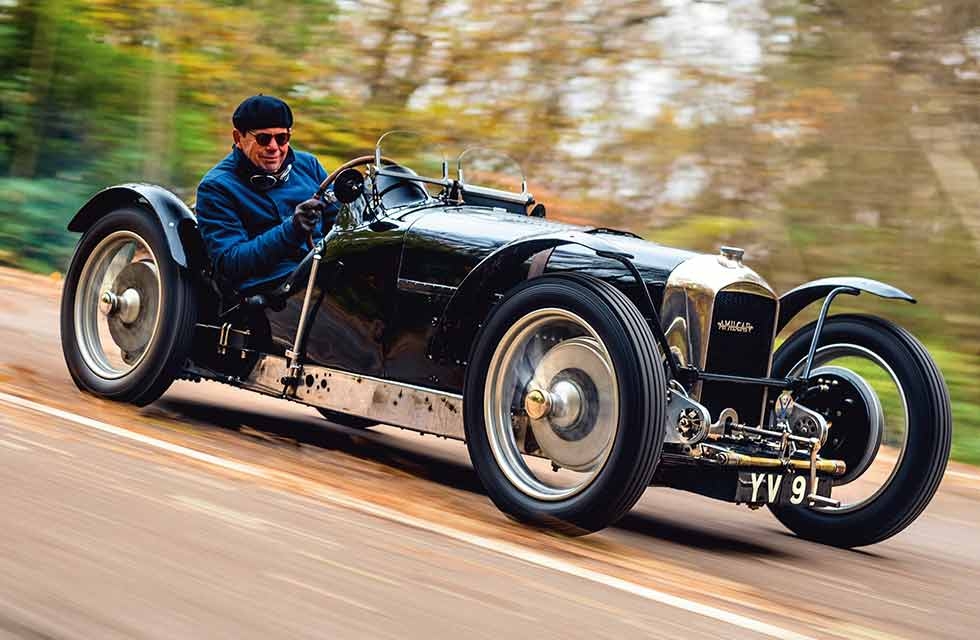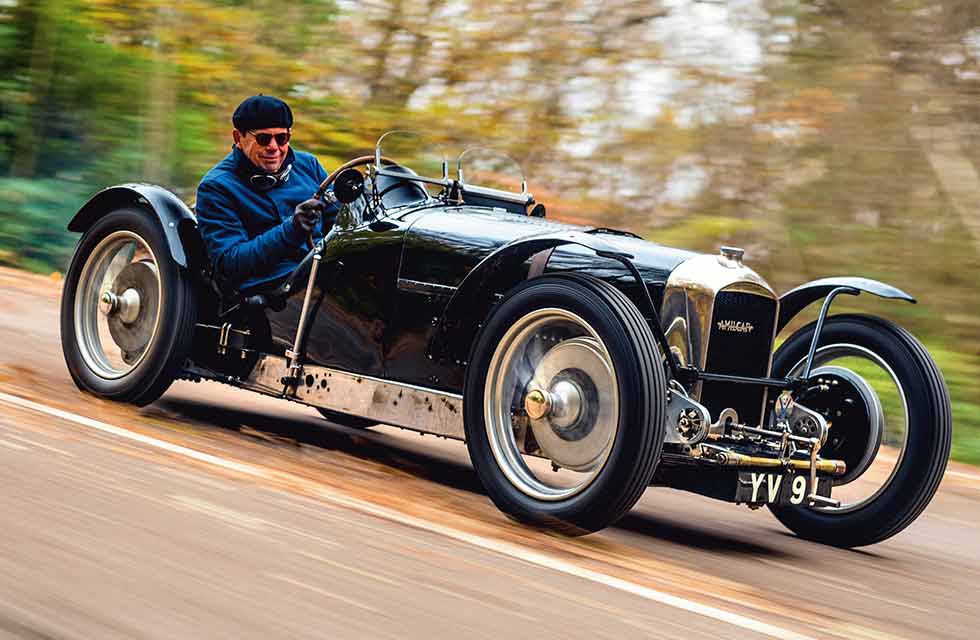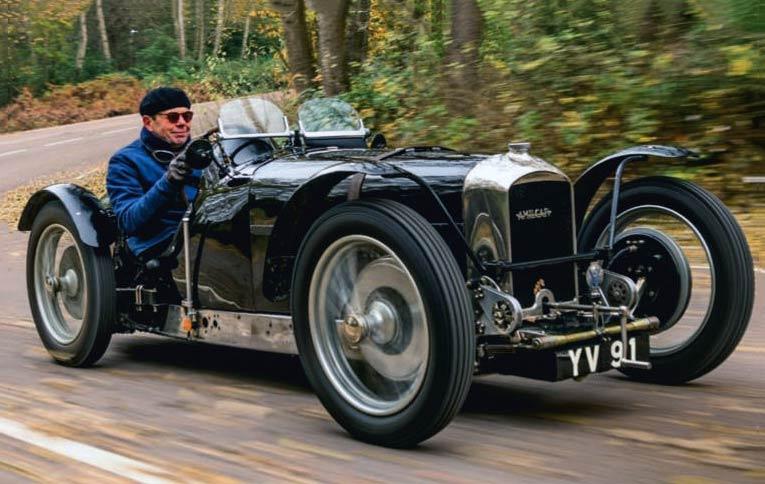
Racing cars converted for the road have a special appeal, none more so than the exotic twin-cam Amilcar C6, the fastest voiturette of its era. Words Mick Walsh. Photography Olgun Kordal.
1927 Amilcar C6 ‘W.E.Humphreys’ Brooklands Voiturette
GRAND PRIX EN MINIATURE – SMALL BUT MIGHTY
Mick Walsh samples a jewel of French engineering, the rasping Amilcar C6
The much-missed technical illustrator Bob Freeman had a great eye for mechanical form. From JAP twin to Merlin V12, beautiful engines quickly fired his artistic ardour, and the gorgeous twin-cam Amilcar ‘six’ was just such a motor that had Freeman digging out his pencil and sketchbook. Lift the low, straight bonnet on this compact Gallic great and it’s easy to see why the design, masterminded by Amilcar’s engineering chief André Morel, inspired one of Freeman’s finest works.

This 1100cc racing gem, which powered the fabulous Type CO (fixed-head, roller-bearing-crank specification) and the detuned semiproduction C6 (later detachable heads, and plain bearings), is one of the best-looking of all vintage engines. Appearing similar to one bank of the legendary Delage V12, its camshafts were driven by spur gears at the rear, while a finned Zoller supercharger sat snugly at the nose of the crankcase. Works CO racers claimed 83bhp at 5600rpm, while even the C6 gave 62bhp.

The dry-sump, double-overhead-cam straight-six was fitted into a low, well-braced but extensively drilled chassis with a neatly contoured doorless body. The bonnet line was just 33in tall. The oil tank hung low between the dumb irons at the front, and the six-into-one exhaust ran outside, racer style, to a neat pointed tail that contained the fuel tank. All up, the ‘production’ C6 weighed just 550kg and the factory confirmed its 100mph performance with a test at Montlhéry near Paris in February 1928.
‘You really feel part of the Amilcar C6, a rare sensation for the era that only Grand Prix Delage drivers experienced’
With its driver and passenger sitting low beside the driveline, the Amilcar ‘six’ looked like a scaled-down Grand Prix machine. Beautifully made with immense pride by the team in the Seine-Saint-Denis works in northern Paris, these voiturettes dominated the 1100cc class all over Europe in the late 1920s.
For years I’ve admired surviving Amilcar ‘sixes’, be it the fabulous Type MCO monoplace yowling around Vintage Montlhéry or among a peaceful Amilcar picnic group at VSCC Prescott. To finally get behind the wheel has been a long-held ambition. After one glance into the tight footwell it’s clear that narrow shoes are essential to work the centre-throttle pedal layout. The array of nine gauges across the stylish engine-turned dashboard includes twin Jaeger rev counters, one for each cam of the twin’s heart. So fanatical was restorer Bernard Harding that he also mounted a fuel-flow meter in the passenger footwell. The old four-spoke steering wheel has been replaced by a more elegant three-spoke that looks straight from a Grand Prix Maserati.

There’s a wonderful range of modifications fitted by Harding, including a passenger handle based around a motorcycle throttle grip and a clutch of washers for the battery clamp made from drilled-out Franc coins. Every aspect has been fastidiously thought out and fettled.
Firing up begins by pressurising the tank with a hand pump. With Ki-gas primed and ignition fully retarded, the modified starter avoids the task of finding a helper to turn it over manually from the front. The little engine barks into life with a glorious rasp that quickly drowns out the noise of gears and blower. The sharp sound belies its junior capacity.
The gearbox requires careful feel to find first because it’s easy to move the swept-back lever too far forward into reverse. But once away the transmission is a total delight, fast and precise. The super-responsive engine makes it a treat to double-declutch, with the rapid downshifts into corners accompanied by that distinctive exhaust through the fishtail pipe close behind. Every aspect of the chassis is communicative.
The steering action is easy and direct, while the later hydraulic brakes have instant feel and power. Within a few miles the car inspires confidence, and through the turns its balance contradicts its vintage age. The CO and C6 must have felt a revelation in the 1920s with their low seating positions and thoroughbred controls. Even on the skinny 19in tyres, the handling feels wonderfully neutral, begging ever-faster cornering speeds as the ‘six’ revs away eagerly.
Push harder and the weight of the oil tank and the blower up front develops into understeer, but the overall impression is of a jazz-age Lotus Seven. You really feel part of the car, a rare sensation for the era that only Grand Prix Delage drivers experienced.
The C6 is a joy to command, its delicate feel emphasising its neat, quality design and construction. Little wonder these great cars were competitive throughout the 1930s, and in early vintage racing gave ERAs a tough time with John Tozer’s determined efforts.
Vernon Balls imported seven C6s, which were no doubt a challenge to sell with the initial £725 price being £200 more than a Bugatti Type 37, when a Riley Brooklands Nine cost only £420.
Balls also offered the C6 as a road car, with starter, dynamo, lights, mudguards, windscreen and hood fitted at extra cost. The factory, meanwhile, had ambitions to run a C6 at Le Mans but never reached the required minimum production run of 50 cars, although Balls did enter a team in the Ards TT in 1928 and ’1929. Fastest in their class, they all failed to finish.
Amilcar C6s were very active at Brooklands, where they proved superfast but gained an unfair reputation for fragility. For the prestigious Junior Car Club’s 200 Miles Race in October 1927, Balls entered three cars with works support. It was the dream UK debut: class domination and a 2-3-4 result overall, just failing to catch Malcolm Campbell’s winning Bugatti.
Balls saw motor racing as a great promotional tool and persisted with the ‘sixes’ but with plain bearings rather than the factory’s special roller bearings. They stood up to high revving around the bumpy Brooklands banking.
“They had excellent acceleration and would run up to 6500rpm,” recalled Balls to Bill Boddy in a 1972 interview. “They were the most marvellous cars.” Balls lapped Brooklands at a remarkable 103.76mph in the supercharged 1100cc C6 during the 1928 season, and this success drew wealthy enthusiasts to Balls’ central London Amilcar showroom at 96 High Holborn.
The early history of this C6, first registered YW 91, is unclear, but its first links are to Balls’ works driver Beris Harcourt-Wood. Within a few years the car had been acquired by WE ‘Bill’ Humphreys and became one of the quickest C6s thanks to preparation and development by Alec Francis. The distinctive black C6, already four years old, was entered for the 1931 500 Miles Race and the low voiturette was dwarfed by the heavy Bentley big guns as it rasped around at 100mph. It looked set for a class win until the front axle broke with just three laps to go.
Humphreys persisted with the C6, with Francis fitting the car with special camshafts and commissioning Amherst Villiers to make a new supercharger that blew at 16psi. Humphreys had the chassis chromium plated during one winter strip-down, making the C6 instantly recognisable.
Later owners included RF Oats, who removed all of the tuning and ran it very successfully in unblown form with twin carbs – it still recorded 96mph laps during the 1934 season!
The car was then acquired by custard magnate F Monkhouse and, together with racer Harry Clayton, he ran a pair of Amilcars at British events. With new tracks at Crystal Palace and Donington, plus the revised Brooklands Mountain Circuit, the Amilcars were tuned for each event, with engines and parts regularly interchanged. Both cars were fitted with Lockheed hydraulic brakes and a special widetrack I-section front axle was used. Clayton recorded a 121.5mph lap at Brooklands in ’1937.
Both ex-Clayton C6s were put into storage through WW2, but, planning for peacetime, Bugatti man Peter Hampton acquired the Humphreys car. During the Normandy Landings in 1944, Hampton’s left arm was severely wounded by shrapnel and any ambitions to race were thwarted by his disability. A year later the C6’s performance reputation still held strong, and Weybridge garage owner Owen Finch bought the Clayton/Monkhouse team C6s and had them converted for the road with the registrations NPA 217 and MPC 702.
Resplendent in new dark-green paint and with quickly removable mudguards, they were regular class contenders at the first post-war events including Gransden Lodge and Prescott’s reopening. Like all tall drivers, Finch looked an ill fit in the cramped cockpit, his bulky physique making it look toy-like as he enthusiastically gunned it up Prescott and around Blandford Camp. Parts were shared to keep the cars running, but Finch sold them in 1950. NPA 217, with wide track and Villiers blower, went to Vic Hern; the Humphreys car continued to compete with new owner George Fisher until offered for sale in 1961. It would remain with the new owner for the following 58 years.
Looking for something faster than his Alvis 12/50, Bernard Harding spotted an advertisement for the well-known Amilcar C6. It came complete with a very heavy, crude trailer, and Harding immediately competed in Vintage Sports-Car Club events, beginning with Silverstone on his first weekend of ownership. The Alvis was enlisted to tow the new acquisition to competitive outings, and early appearances included Goodwood where he lined up with two other C6s against seven ERAs. Although the handling of Harding’s C6 initially proved a challenge, it was soon much-improved with development. With oil leaks sorted and running on 80% methanol, the car became competitive.
After two busy circuit racing and hillclimb seasons, he capped 1963 with the Boxing Day meeting at Brands Hatch and braved a snowstorm until the C6’s rear axle failed. This was to prove Harding’s last race: the plan was just an engine rebuild over the winter, but the strip-down turned into a full restoration.
Various projects distracted Harding from the task (including learning to fly), but by the 1980s retirement allowed his focus to return to the C6. The decision was made during the meticulous rebuild to prepare it for the road, with work tuning the C6 for pump fuel. Other practical modifications included a Scintilla starter and dynamo, just as fitted by Balls, while the authentic 19in-tall wheels were reinstated.
Harding logged 6000 hours on the restoration and many aspects of this fabulous machine highlight his attention to detail. The final touch was securing the YV 91 works registration.
As well as Amilcar Register events, Harding and his immaculate black C6 were a highlight of Brooklands Reunions in the following 20 years, where in 2003 it won the trophy for the ‘car the judges would most like to take home’. With the original exhaust system made by Owen Finch refitted, including the Brooklands silencer and the fishtail, the C6 sounded as sharp as it looked.
This great little car is a wonderful tribute to Harding, a brilliant old-school engineer who died in 2019. As with all his machines, Harding’s focus was as much the design and precise fettling as it was the driving experience. Born in 1924 in Calcutta, where his father was stationed with the Royal Army Military School, Harding was educated at Charterhouse. He joined the Royal Engineers as soon as he was old enough at the start of WW2 and ended up back in India where he maintained everything from steamrollers to small power stations.
With peacetime Harding resumed his academic career at the University of Birmingham, where he studied engineering to Masters level and rode a Vincent Black Shadow motorcycle.
Upon joining the National Gas Turbine Establishment his projects included Concorde before he moved to the Fighting Vehicle Research and Development Establishment, at Chobham in Surrey, until he retired in 1984.
At Sprockets, his home near Woking, Harding owned and restored an eclectic range of machinery from vintage ‘flat-tank’ Nortons to his 1928 Frazer Nash. His daily transport was a pair of trusty Morris Minors. His interest in aviation continued with a DH Hornet Moth, which he flew and worked on. Never a blinkered marque obsessive, Harding was always keen to try different designs but the Amilcar C6 remained a keeper until his passing aged 95.
The Gallic jewel was meticulously maintained and kept cosseted inside a conservatory at his home. Even after his final trip to Brooklands in the Amilcar he continued to look after it into his 90s, taking the plugs out, lubricating the bores and regularly turning over the engine.
“As well as his excellent theoretical engineering knowledge, Bernard was a competent machinist,” recalls his friend Peter Bignell. Harding took up painting in his later years, which, as with all his hobbies, he soon mastered. He never painted a picture of the long-treasured C6 but greatly admired Freeman’s artwork. For those who discover these French masterpieces, the fascination is lasting. I’ll never pass one without longing to see and hear that fabulous little twin-cam.
Thanks to Dylan Miles (www.dylan-miles.com); Peter Bignell; Gilles Fournier. The C6 will be on display at Rétromobile (www.retromobile.com)
Left: Owen Finch finds the limit at Blandford Camp in 1949. Below: Vernon Balls (third from left) and crew at the ’1928 Ards TT, having adopted kittens as mascots. The late Bernard Harding and the Amilcar C6 in 1998, back at Brooklands where the experienced Harry Clayton lapped at 121.5mph in 1937. The short tail and long nose betray the Amilcar C6’s racing intentions – low-slung, purposeful and for sporting drivers. The straight-six is engineering as art, as illustrator Freeman’s intricate watercolour proves (inset). ‘Bill’ Humphreys’ immaculate C6 warms up for the 1930 500 Miles Race at Brooklands.






